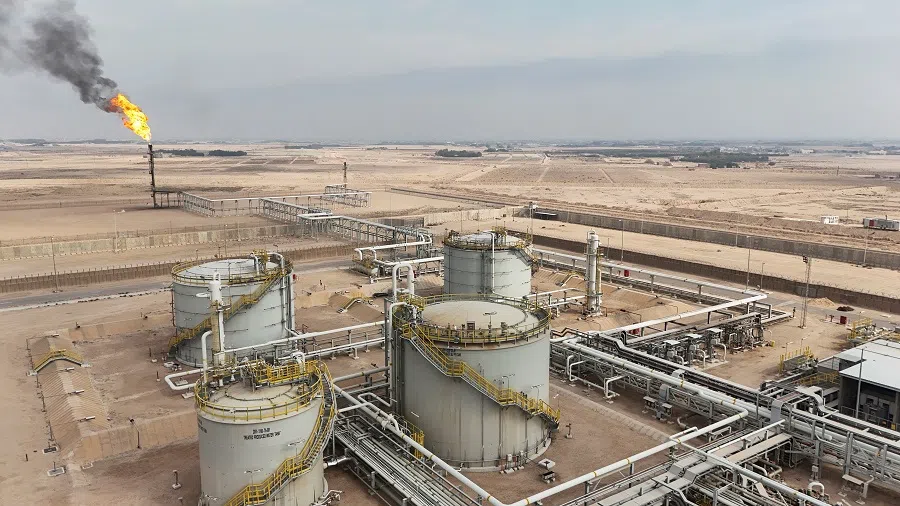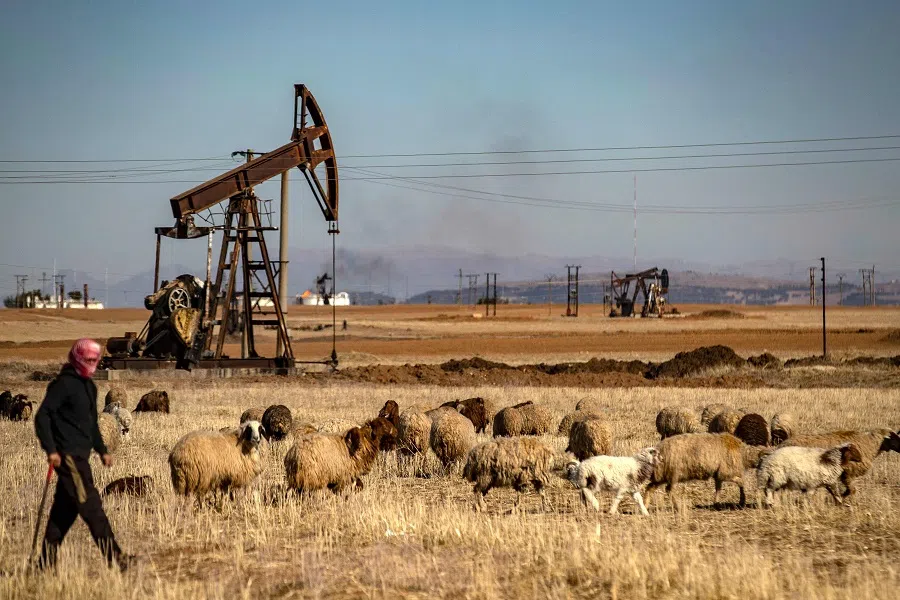Losing ground: How China is outpacing the US in the Gulf’s green energy race
US academic John Calabrese observes that the US pullback from climate commitments under Trump could bolster China’s clean tech trade, while tariffs may push Chinese firms to expand in markets like the Gulf. However, rising US-China tensions may also pressure Gulf states to limit tech ties with Beijing. Consequently, the China-Gulf partnership in clean tech is poised to become a defining feature of the Middle East’s energy landscape.

The strategic and economic relationship between China and the Gulf Arab states has deepened significantly over recent decades, underpinned by energy ties that remain central to their partnership. While fossil fuels have long been the cornerstone, their collaboration has expanded into infrastructure development, economic diversification, and increasingly, renewable energy and clean technology. However, this evolving relationship does not exist in isolation. The intensifying US-China rivalry casts a complex shadow over the Gulf’s strategic calculus, introducing competing economic, technological and security interests.
Energy as relationship foundation
Since 2017, China has been the largest consumer of Middle East crude oil. In 2023, China imported record volumes to supply the country’s rising refining capacity, sourcing over half from Middle East producers, led by Saudi Arabia and Iraq. Oman, the United Arab Emirates (UAE), and Kuwait are also among China’s top ten suppliers.
China-Gulf energy interdependence is also evident in both the natural gas (LNG) and the petrochemicals sectors. In 2023, Qatar accounted for one-quarter of China’s LNG imports, making it the country’s second-largest supplier after Australia, with imports poised to grow under new long-term contracts. China-Gulf petrochemical partnerships ensure China with a steady supply of feedstocks for industrial growth while providing Gulf states market access and diversification.
Saudi Arabia, the world’s largest oil exporter, sees its partnership with China as vital for sustained demand and market stability. Similarly, despite geopolitical tensions with the US, Iran has deepened its ties with China to safeguard oil exports, particularly under American sanctions. Reports indicate that Iran’s petroleum exports soared to new highs in 2024, with China serving as the primary destination for virtually all shipments. Roughly half to two-thirds of Iraq’s oil production now comes from fields where Chinese firms are involved in investment, production or servicing capacities.
Despite China’s ambitious carbon neutrality goals, its dependence on oil and gas from the Gulf is expected to persist for the foreseeable future.

Despite China’s ambitious carbon neutrality goals, its dependence on oil and gas from the Gulf is expected to persist for the foreseeable future. This balancing act — managing emissions while maintaining energy security — highlights the complexity of China’s energy relationship with the Gulf, which continues to provide essential supplies while China works to reduce coal consumption and invest in sustainable energy sources.
Broadening scope: renewable energy and clean tech
Over the years, the scope of China-Gulf energy ties has broadened, especially as the global energy transition accelerates, incorporating not just traditional oil and gas exports, but also renewable energy technologies and clean tech. This evolving partnership now includes large-scale renewable energy projects, joint ventures and investments in solar power, wind energy and energy storage, reflecting a shift toward sustainability.
China’s push for green energy solutions and a more sustainable energy strategy in the Gulf is not only about market access but also about strengthening its position as a global leader in clean tech. The “new three” sectors — solar power, batteries, and electric vehicles — have become key growth engines, with almost half of China’s exports in these areas flowing to the global south, according to UN Comtrade data. As the world’s largest investor in renewable energy infrastructure, China demonstrates its resolve to protect its vested interests and influence the global clean energy landscape through its partnerships in the Gulf.
Gulf states are increasingly leveraging Chinese renewable energy technologies to advance their clean energy goals, capitalising on China’s overcapacity in manufacturing and competitive pricing.
The Gulf’s ambitions to achieve net-zero carbon emissions by mid-century — Saudi Arabia’s Vision 2030 and the UAE’s Net Zero 2050 initiative, for example — align closely with China’s dominance in the clean energy sector. Gulf states are increasingly leveraging Chinese renewable energy technologies to advance their clean energy goals, capitalising on China’s overcapacity in manufacturing and competitive pricing.
The region’s acute vulnerability to climate impacts — including severe water scarcity and extreme heat — makes this transition particularly urgent. For these states, renewable energy investment represents more than economic diversification; it is a cornerstone of their strategy for long-term resilience and adaptation.

The Gulf states view collaboration with China as a key opportunity to advance their ambitious clean energy goals efficiently. Saudi Arabia is investing aggressively in renewable energy and strategic partnerships, notably with China. Chinese firms in the Gulf have rapidly transitioned from suppliers and contractors to co-developers and investors, exemplified by the Silk Road Fund’s 49% stake in ACWA Power and their joint investment in Dubai’s Mohammed Bin Rashid Al Maktoum Solar Park.
Indeed, China, as the world’s leader in renewable energy manufacturing, has increasingly become a key player in the Gulf’s energy transition. China’s strength in the clean energy sector is due in large part to its vast manufacturing base, which benefits from economies of scale and government support. This dominance enables the Gulf to meet renewable energy targets through access to advanced, affordable technologies, cementing the strategic value of the partnership.
China’s growing investments in renewable energy and clean tech in the Gulf also align with its broader Belt and Road Initiative (BRI). The BRI aims to connect Asia, Africa, and Europe through trade and infrastructure development, and the Gulf states are key partners in this ambitious plan. By expanding its investments in clean energy projects, China is not only increasing its economic influence in the Gulf but also advancing its geopolitical agenda.
Rising tariffs and trade barriers in the US and Europe have made the Gulf and the wider Middle East an especially appealing destination for Chinese clean energy exports. This trend underscores the region’s importance as a stabilising force for China’s green energy exports amid ongoing geopolitical tensions.
Despite the intensifying US-China rivalry, under the Biden administration, Washington did not aggressively counter China’s growing involvement in the Gulf states’ renewable energy sector.
For the Gulf, access to low-cost Chinese technologies facilitates renewable energy development at competitive prices. For China, the Gulf offers a growing market that strengthens its leadership in global green tech exports, creating a mutually advantageous partnership.
The International Energy Agency (IEA) forecasts that China will reinforce its position as the dominant global manufacturing hub for clean technology, despite the significant effects of the US Inflation Reduction Act, the Bipartisan Infrastructure Law, the European Union (EU)’s Net-Zero Industry Act, and India’s Production Linked Incentive Scheme.
Increasingly difficult for US firms to compete
Despite the intensifying US-China rivalry, under the Biden administration, Washington did not aggressively counter China’s growing involvement in the Gulf states’ renewable energy sector. This strategic non-interference seemed to reflect a pragmatic recognition that such collaborations align with global goals, such as advancing the transition to sustainable energy, and do not pose an immediate threat to security.
Meanwhile, Biden actively promoted US-Gulf clean energy cooperation, as seen in the UAE’s Masdar acquiring a 50% stake in US renewables firm Terra-Gen just weeks before the 2024 election. The deal underscored deepening US-UAE ties in the sector, headlined by the Partnership for Accelerating Clean Energy (PACE), a US$100 billion initiative launched in 2022 to deploy 100 GW of clean energy globally.

Under President Trump’s second term, the administration has doubled down on its “energy dominance” agenda, emphasising traditional energy sources like oil and gas while withdrawing from the Paris Climate Agreement. Biden’s clean energy diplomacy, including PACE, now faces an uncertain future under Trump, who has signalled a shift away from prioritising renewable energy investment. This policy shift contrasts sharply with China’s assertive push in renewable energy markets, where it has emerged as a dominant global player.
US engagement in the Gulf has traditionally prioritised security cooperation, arms sales and ensuring regional energy stability, rather than competing economically in renewable energy. The rise of China as a leader in the renewable energy supply chain has made it increasingly difficult for US firms to compete, particularly in the Gulf, where cost-effective and scalable solutions are paramount. While Trump’s administration is poised to focus on traditional energy exports and expanding fossil fuel markets, China is leveraging its manufacturing dominance to provide Gulf states with rapid investments in renewable energy infrastructure.
For Gulf states, China’s ability to deliver large-scale renewable energy projects with minimal conditions has positioned it as a key partner for infrastructure development. This contrasts with the US, where clean energy firms have often been deterred by lower profitability margins in the Gulf’s emerging markets. The administration’s energy policies, which deprioritise renewables, have further diminished US competitiveness in this space, effectively leaving China to dominate the Gulf’s renewable energy sector.
This approach reflects a calculated focus on leveraging US strengths, such as security and defence, while leaving renewable energy as a domain where China’s leadership is accepted, if not openly contested.
US efforts concentrated on reinforcing geopolitical presence
In the Gulf, where cost-effectiveness and scalable solutions are paramount, the US still retains significant advantages. The government has a suite of tools, including export assistance via the US Export‐Import Bank and its Environmental Exports Program, which can help American companies capture new opportunities. Moreover, the Trump team has cultivated strong personal relationships with Gulf leaders — especially in Saudi Arabia and the UAE — that may help mitigate any short-term setbacks.
However, while these export tools and diplomatic ties are assets, the emergence of a comprehensive, competition-driven strategy aimed at giving Chinese clean tech a serious run for their money seems unlikely in the near term. The current approach appears more reactive — focusing on reversing previous policies rather than building a robust, forward-looking clean tech competitiveness agenda.
The broader geopolitical context also shapes the US approach. While Trump’s administration views China’s influence in areas like military cooperation or telecommunications as a direct security threat, its involvement in the Gulf’s renewable energy sector has not been framed in similar terms. Instead, US efforts have concentrated on reinforcing geopolitical presence through military alliances and security cooperation, where American influence remains strongest. This divergence highlights a shift in energy geopolitics, where access to renewable energy technologies has become as critical as securing traditional energy resources.
By allowing China to take the lead in renewable energy development in the Gulf, the US implicitly acknowledges the region’s growing importance as a hub for the green energy transition. At the same time, Trump’s emphasis on energy dominance and fossil fuel exports signals a preference for consolidating traditional energy partnerships over entering a competitive renewable energy arena dominated by China. This approach reflects a calculated focus on leveraging US strengths, such as security and defence, while leaving renewable energy as a domain where China’s leadership is accepted, if not openly contested.
The partnership between China and the Gulf Arab states is set to deepen in the coming years, driven by the dual forces of the global energy transition and China’s leadership in renewable energy manufacturing. As Gulf states pursue economic diversification and embrace renewable energy goals, their collaboration with China will strengthen further. For instance, projects like Saudi Arabia’s Red Sea Solar Initiative or the UAE’s growing portfolio of Chinese-financed clean energy ventures illustrate the practical dimensions of this partnership. This evolving collaboration could serve as a model for future energy alliances in a low-carbon global energy landscape.

China’s BRI lies at the heart of its expanding influence in the Middle East, with Gulf states occupying a central role in Beijing’s energy and infrastructure strategy. By leveraging its expertise in green technologies and its capacity for rapid project execution, China offers the Gulf states a valuable partner in achieving their renewable energy goals. Simultaneously, Gulf states provide China with crucial markets for its renewable energy technologies and further solidify their role in global energy governance.
As the Gulf states increasingly look to China for renewable energy technologies and infrastructure investments, the US finds itself facing a more complex and competitive landscape in a region it once dominated.
Although US-China rivalry remains a significant geopolitical factor, it has not disrupted the growing China-Gulf collaboration in renewable energy. The US pullback from climate commitments under Trump could bolster China’s clean tech trade, while tariffs may push Chinese firms to expand in markets like the Gulf. However, rising US-China tensions may also pressure Gulf states to limit tech ties with Beijing. Consequently, the China-Gulf partnership in clean tech is poised to become a defining feature of the Middle East’s energy landscape, with implications extending beyond the region as global powers recalibrate their energy strategies.
A more complex and competitive landscape
The China-Gulf relationship, traditionally centered around oil and gas, is evolving with a growing emphasis on renewable energy and clean tech. As the Gulf states increasingly look to China for renewable energy technologies and infrastructure investments, the US finds itself facing a more complex and competitive landscape in a region it once dominated.
Despite US concerns about China’s growing influence in clean tech, many countries in the global south, including Gulf states, see China’s green manufacturing strengths not as “overcapacity”, but as valuable enablers of their economic and climate goals. If the US, under the Trump administration, rolls back its investments in clean tech as expected, China’s “new three” sectors — solar, batteries, and electric vehicles — will likely capture more opportunities in developing countries, including the Gulf and with Gulf partners in third countries. This shift risks not only forfeiting the global clean tech race to China but, given clean tech’s role as a form of soft power, ceding influence as well.
The China-Gulf partnership has the potential to help drive the region’s energy transition, underscoring the growing role of economic diplomacy in shaping its future. Achieving sustainable economic development will require the Gulf countries to deftly manage “great-power competition” such that they capitalise on China’s green manufacturing capabilities while ensuring their security relationship with the US remains intact.





